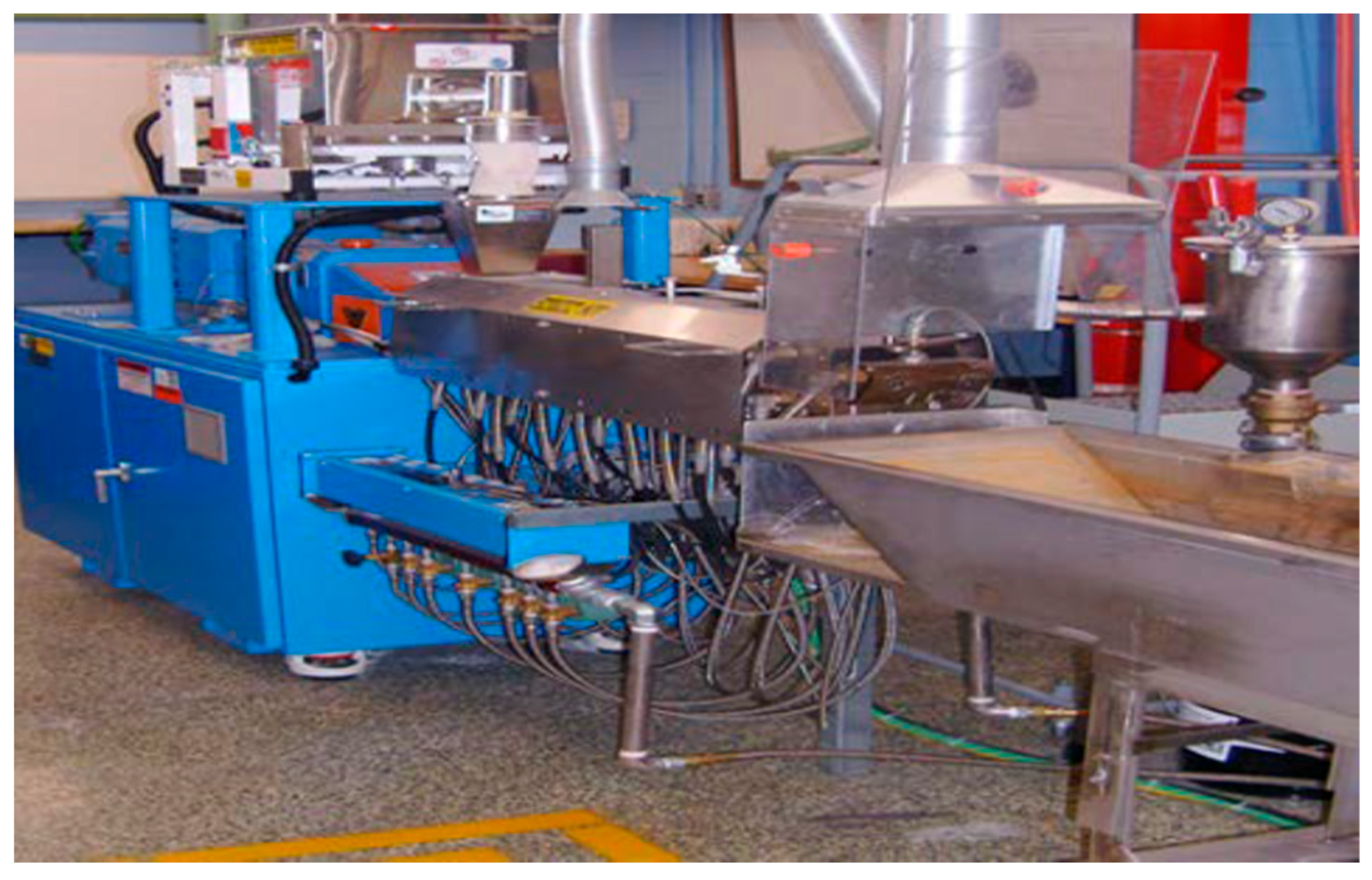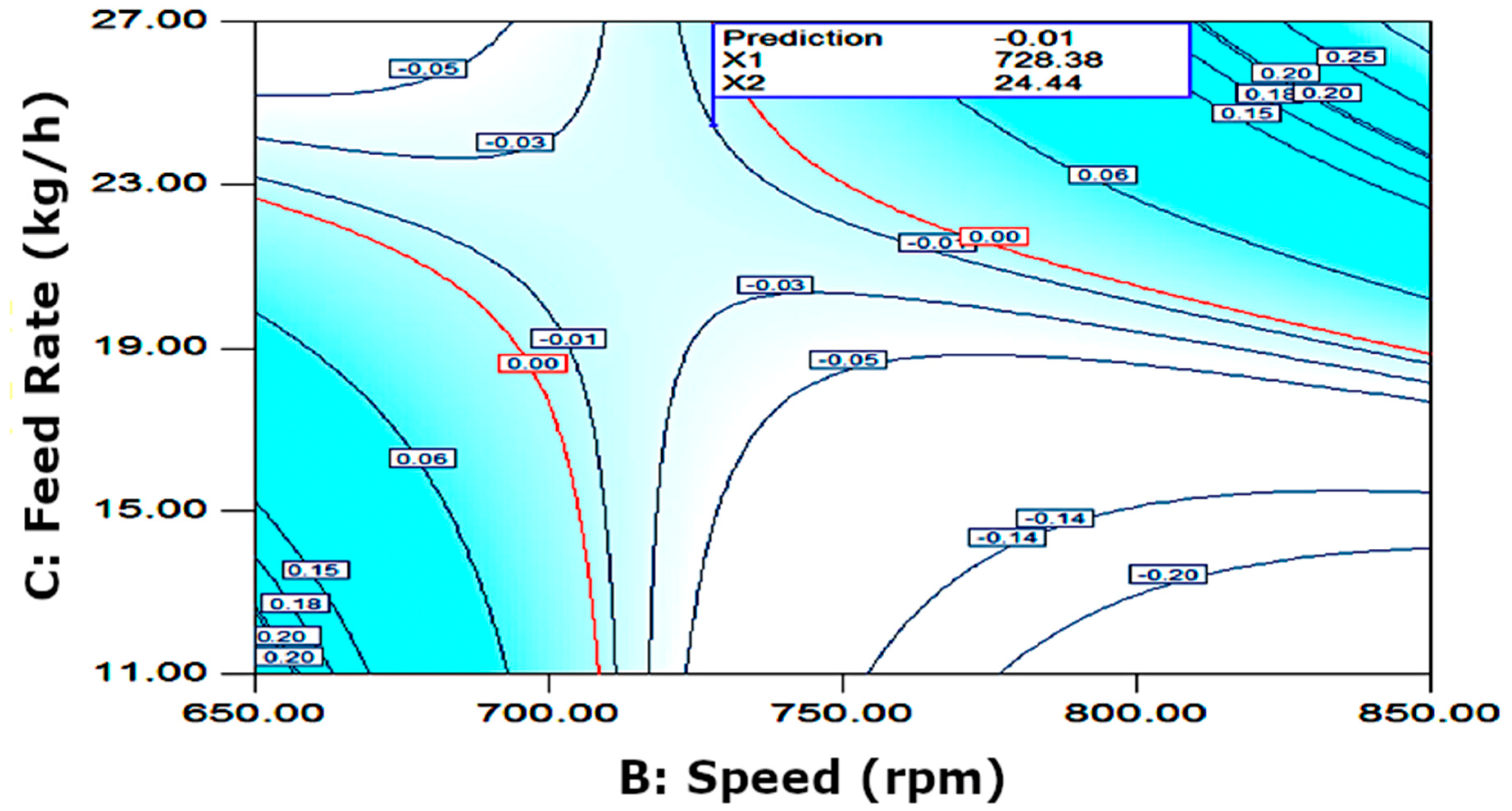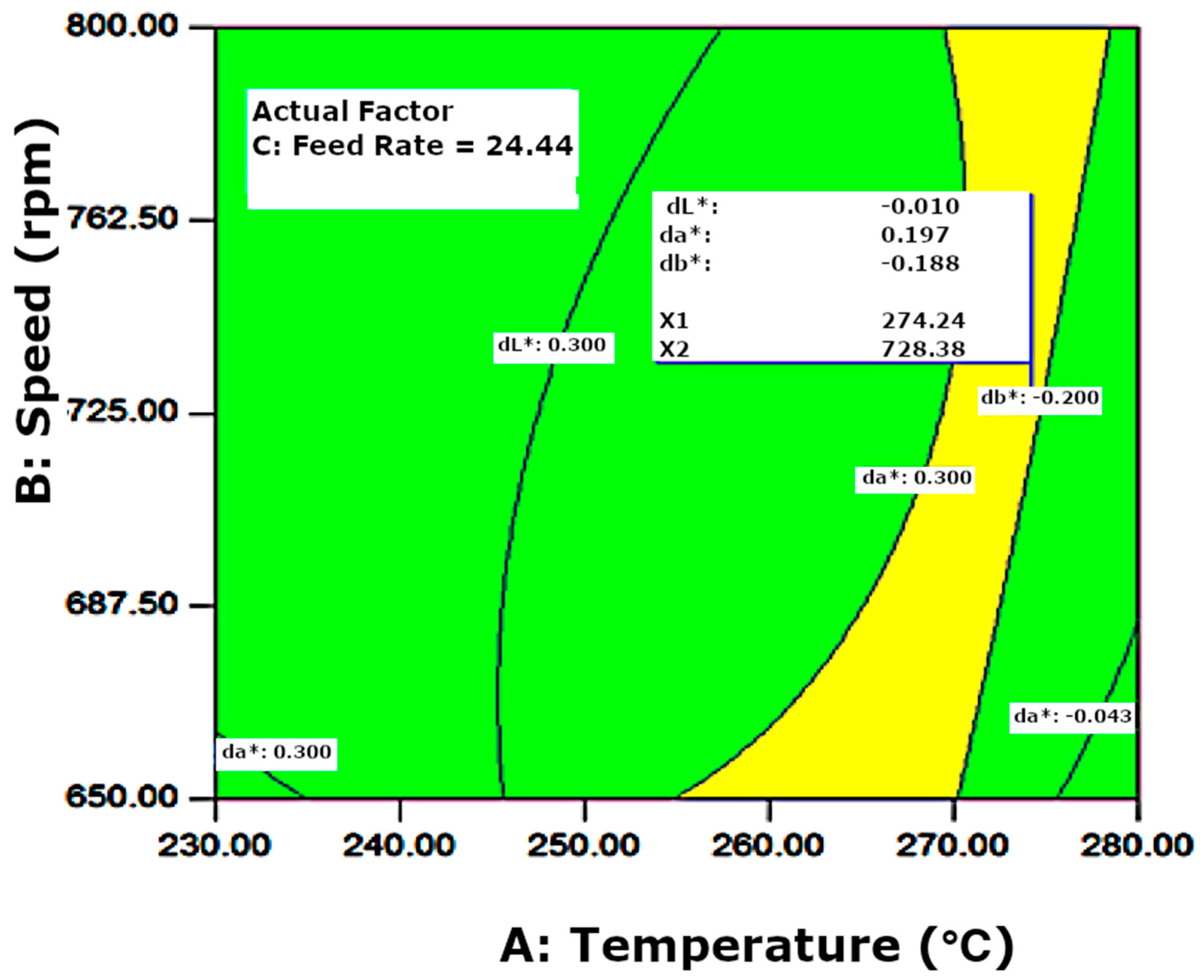Optimization of Execution Microscopic Extrusion Parameter Characterizations for Color Polycarbonate Grading: General Trend and Box–Behnken Designs
Abstract
:1. Introduction
- is the predicted response;
- β0 is constant;
- k is the number of factors;
- xi is an independent variable;
- βi is the ith coefficient in the linear equation;
- βii is the ith coefficient in the quadratic equation;
- βij is the ith coefficient of interaction;
- ε is the error.
2. Experimental and Statistical Methods
- Number mining, involving the selection of diverse formulations and processing parameters linked to color discrepancies based on historical data.
- RSM experiments, which are employed when a few significant factors are involved in optimization. Various types of RSM designs, such as full factorial design, central composite design (CCD), Box–Behnken design (BBD) and D-optimal design, were utilized. RSM serves as a practical tool for evaluating the impact of multiple variables and their interactions on either single or multiple response variables. Moreover, the study juxtaposed RSM with alternative optimization methods, including artificial neural networks (ANNs) [15]. Moreover, advanced statistical analysis was conducted using RSM and microstructural examination via scanning electron microscopy (SEM) to optimize the process [16]. The statistical analysis in this study is focused on scrutinizing the thermal gelation tendencies of two known reactants employing RSM; partially hydrolyzed polyacrylamide (PHPA) and polyethyleneimine (PEI). The significance of the model was validated against experimental data with a confidence level of 95% through analysis of variance (ANOVA) [17].
- Box–Behnken Design (BBD)
- b.
- General Trends (GTs)
3. Experimental Setup (Materials and Equipment)
3.1. Materials
3.2. Compounding on Twin-Screw Extruder
3.3. Sample Preparation by Rotary Microtome
3.4. Scanning Electron Microscopy (SEM)
3.5. Characterization
4. Discussion and Findings
5. Conclusions
Author Contributions
Funding
Institutional Review Board Statement
Informed Consent Statement
Data Availability Statement
Conflicts of Interest
References
- Rwei, S.P. Distributive mixing in a single-screw extruder—evaluation in the flow direction. Polym. Eng. Sci. 2001, 41, 1665–1673. [Google Scholar] [CrossRef]
- Wong, A.Y. Single-Screw Extrusion & Screw Configuration Effects on The Color Mixing Characteristics of Polymer; Sichuan Union University: Chengdu, China, 1998. [Google Scholar]
- Kimura, K.; Nakayama, Y.; Kajiwara, T. Distributive mixing characteristics of a Dulmage-type screw for a single-screw extruder: Experimental and numerical evaluation. Chem. Eng. J. Adv. 2021, 7, 100137. [Google Scholar] [CrossRef]
- Wong, Y.A. Quantification for dynamic mixing performance of single screws for different configurations: Visualization and image analysis. Adv. Polym. Technol. 2009, 28, 1–15. [Google Scholar] [CrossRef]
- Meade, D.I. Introduction to colorant selection and Application Technology. In Coloring of Plastics, Fundamentals, 2nd ed.; Charvat, R.A., Ed.; John Wiley & Sons, Inc.: Hoboken, NJ, USA, 2004; ISBN 9780471139065. [Google Scholar] [CrossRef]
- Müller, A. Coloring of the Plastics; Hanser Carl Verlag: Munich, Germany, 2003. [Google Scholar]
- ASTM D 2244-93; Standard Test Method for Calculation of Color Differences from Instrumentally Measured Color Coordinates. ASTM: West Conshohocken, PA, USA, 2000; pp. 215–222.
- Hunter Lab. The Basics of Color Perception and Measurement. 2001. Available online: https://www.hunterlab.com/media/documents/basics-of-color-theory.pdf (accessed on 30 January 2022).
- Abrams, R.; Ali, M.; Denton, P.; Igualada, J.; Groen, M.; Gschwind, E. Colouring plastics: Fundamentals and trends. Plast. Addit. Compd. 2001, 3, 18–25. [Google Scholar] [CrossRef]
- Markarian, J. US compounding industry faces challenging times. Plast. Addit. Compd. 2008, 10, 38–41. [Google Scholar] [CrossRef]
- Anderson, M.J.; Whitcomb, P.W.; Simplified, R.S. Optimizing Processes Using Response Surface Methods for Design of Experiments; Productivity Press: New York, NY, USA, 2005. [Google Scholar]
- Borror, C.N. Evaluation of Statistical Designs for Experiments Involving Noise Variables. J. Qual. Technol. 2002, 34, 54–70. [Google Scholar] [CrossRef]
- Douglas Montgomery, C. Design and Analysis of Experiments, 6th ed.; John Wiley and Sons: New York, NY, USA, 2019. [Google Scholar]
- Mishra, A. Application of Box-Benhken experimental design for optimization of laccase production by Coriolus versicolor MTCC138 in solid-state fermentation. Sci. Ind. Res. 2008, 67, 1098–1107. [Google Scholar]
- Boublia, A.; Lebouachera, S.E.I.; Haddaoui, N.; Guezzout, Z.; Ghriga, M.A.; Hasanzadeh, M.; Benguerba, Y.; Drouiche, N. State-of-the-art review on recent advances in polymer engineering: Modeling and optimization through response surface methodology approach. Polym. Bull. 2023, 80, 5999–6031. [Google Scholar] [CrossRef]
- Belkahla, Y.; Mazouzi, A.; Lebouachera, S.E.I.; Hassan, A.J.; Fides, M.; Hvizdoš, P.; Cheniti, B.; Miroud, D. Rotary friction welded C45 to 16NiCr6 steel rods: Statistical optimization coupled to mechanical and microstructure approaches. Int. J. Adv. Manuf. Technol. 2021, 116, 2285–2298. [Google Scholar] [CrossRef]
- Mazouzi, A.; Rezzoug, A.; Cheniti, B.; Lebouachera, S.E.I.; Miroud, D.; Boukantar, A.-R.; Drouiche, N.; Djerdjare, B. Impact of wear parameters on NiCr-WC10Co4Cr and WC10Co4Cr HVOF sprayed composite coatings using response surface methodology. Int. J. Adv. Manuf. Technol. 2021, 114, 525–539. [Google Scholar] [CrossRef]
- Lebouachera, S.E.I.; Ghriga Salha, B.G.; El Hadri, H.; Hasanzadeh, M.; Drouiche, N.; Reynaud, S.; Grassl, B. Optimization of zero-shear viscosity for HPAM-Polystyrene microspheres formulations through experimental design approach. J. Polym. Res. 2021, 28, 135. [Google Scholar] [CrossRef]
- Ghriga, M.A.; Hasanzadeh, M.; Gareche, M.; Lebouachera, S.E.I.; Drouiche, N.; Grassl, B. Thermal gelation of partially hydrolysed polyacrylamide/polyethylenimine mixtures using design of experiments approach. Mater. Today Commun. 2019, 21, 100686. [Google Scholar] [CrossRef]
- Lebouachera, S.E.I.; Chemini, R.; Khodja, M.; Grassl, B.; Ghriga, M.A.; Tassalit, D.; Drouiche, N. Experimental design methodology as a tool to optimize the adsorption of new surfactant on the Algerian rock reservoir: cEOR applications. Eur. Phys. J. Plus 2019, 134, 436. [Google Scholar] [CrossRef]
- Duce, C.; Bernazzani, L.; Bramanti, E.; Spepi, A.; Colombini, M.P.; Tine, M.R. Alkyd artists’ paints: Do pigments affect the stability of the resin? A TG and DSC study on fast-drying oil colours. Polym. Degrad. Stab. 2014, 105, 48–58. [Google Scholar] [CrossRef]
- Chang, K.Y. Effect Of Some Extrusion Variables On Rheological Properties And Physicochemical Changes Of Cornmeal Extruded By Twin Screw Extruder. Braz. J. Chem. Eng. 1998, 15. [Google Scholar] [CrossRef]
- Fatoni, R. Product Design of Wheat Straw Polypropylene Composite; University of Waterloo: Waterloo, ON, USA, 2012. [Google Scholar]
- Islam, M.A.; Sakkas, V.; Albanis, T.A. Application of statistical design of experiment with desirability function for the removal of organophosphorus pesticide from aqueous solution by low-cost material. J. Hazard. Mater. 2009, 170, 230–238. [Google Scholar] [CrossRef] [PubMed]
- Ahmed, S.; Al-Sadi, J.; Saeed, U.; Rizvi, G.; Ross, D.; Clarke, R.; Price, J. Process Optimization through Designed Experiments to Achieve Consistency in Output Color of a Compounded Plastic Grade; Taylor & Francis: Abingdon, UK, 2015; Volume 27. [Google Scholar]
- Sadi, J.A. Designing Experiments: Three Level Full Factorial Design and Variation of Processing Parameters Methods for Polymer Colors. Adv. Sci. Technol. Eng. Syst. J. 2018, 3, 109–115. [Google Scholar] [CrossRef]
- Alsadi, J. Investigation of the effects of Formulation, process parameters, Dispersions and Rheology on using combined Modelling and experimental Simulations. Mater. Today Proc. 2019, 13, 530–540. [Google Scholar] [CrossRef]
- Alsadi, J. A revised approach to rheological behavior and processing parameters of polycarbonate compound. In Proceedings of the Annual Conference of the SPE (ANTEC), Anaheim, CA, USA, 8–10 May 2017; pp. 249–255. [Google Scholar]
- Alsadi, J. Study on effect of dispersion and processing parameters in microscopically evaluated color of plastic grade. J. Am. Inst. Phys. 2019, 2139, 110007. [Google Scholar]
- Alsadi, J. Systematic review: Impact of Processing Parameters on Dispersion of Polycarbonate Composites and Pigment Characterized by Different techniques. Mater. Today Proc. 2020, 27, 3254–3264. [Google Scholar] [CrossRef]
- Alsadi, J.; Ismail, R.; Trrad, I. An Integrative Simulation for Mixing Different Polycarbonate Grades with the Same Color: Experimental Analysis and Evaluations. Crystals 2022, 12, 423. [Google Scholar] [CrossRef]
- Alsadi, J.; Obaidat, M.T.; Ismail, R.; Trrad, I.; Aljamal, M.; Dahim, M.; Abuaddous, M.; Khodier, M.; Hatamleh, R.; Al-Mattarneh, H. Box–Behnken Design for Polycarbonate-Pigment Blending: Applications and Characterization Techniques. Polymers 2022, 14, 4860. [Google Scholar] [CrossRef] [PubMed]






| Processing | Parameters | 3 Code Levels | ||
|---|---|---|---|---|
| −1.0 | 0.0 | +1.0 | ||
| T | degrees Celsius (°C) | 230 | 255 | 280 |
| S | revolutions per minute (rpm) | 650 | 750 | 850 |
| FR | kilograms per hour (kg/h) | 11 | 19 | 27 |
| Run | dL* | da* | db* | dE* | ||||
|---|---|---|---|---|---|---|---|---|
| Actual Values | Predicted Values | Actual Values | Predicted Values | Actual Values | Predicted Values | Actual dE* | Predicted dE* | |
| a | −0.12 | −0.062 | −0.017 | −0.023 | −0.36 | −0.24 | 0.40 | 0.25 |
| b | −0.26 | −0.2 | 0.07 | 0.038 | −0.27 | −0.43 | 0.40 | 0.50 |
| c | 0.27 | 0.18 | 0.63 | 0.6 | 0.39 | 0.18 | 0.79 | 0.65 |
| d | −0.037 | 0.006 | −0.043 | 0.012 | −0.34 | −0.2 | 0.35 | 0.200 |
| e | 0.006 | −0.025 | −0.027 | −0.044 | −0.29 | −0.39 | 0.29 | 0.39 |
| f | 0.3 | 0.18 | 0.65 | 0.6 | 0.39 | 0.18 | 0.82 | 0.65 |
| g | 0.12 | 0.18 | 0.58 | 0.6 | −0.003 | 0.18 | 0.59 | 0.65 |
| h | 0.51 | 0.59 | 0.38 | 0.36 | 0.14 | 0.14 | 0.65 | 0.71 |
| i | −0.1 | −0.1 | 0.11 | 0.13 | −0.31 | −0.25 | 0.34 | 0.30 |
| j | 0.15 | 0.18 | 0.58 | 0.6 | −0.047 | 0.18 | 0.60 | 0.65 |
| k | 0.59 | 0.52 | 0.36 | 0.33 | 0.11 | 0.094 | 0.700 | 0.62 |
| l | 0.47 | 0.56 | 0.36 | 0.4 | −0.023 | −0.048 | 0.59 | 0.69 |
| m | 0.2 | 0.18 | 0.57 | 0.6 | 0.37 | 0.18 | 0.71 | 0.65 |
| n | 0.55 | 0.57 | 0.32 | 0.33 | 0.12 | 0.19 | 0.65 | 0.69 |
| o | 0.36 | 0.39 | 0.29 | 0.3 | −0.13 | −0.087 | 0.48 | 0.500 |
| p | 0.19 | 0.14 | 0.2 | 0.17 | −0.22 | −0.17 | 0.35 | 0.28 |
| q | 0.53 | 0.469 | 0.37 | 0.36 | 0.15 | 0.202 | 0.66 | 0.63 |
| Serial no. | Type (MFI) | PPH (Parts Per Hundred) |
|---|---|---|
| 1 | Resin1 25 g/10 min | 33.0 |
| 2 | Resin 10 g/10 min | 67.0 |
| 3 | Pig1 | 0.200 |
| 4 | Pig2 | 0.050 |
| 5 | Pig3 | 0.00040 |
| 6 | Pig4 | 0.00160 |
| 7 | F1, F2, F3 | 0.07100 |
| Variation Responses | Sign. Parameters | (R2) Values | Predicted Values of (R2) | Adjacent Values of (R2) | Adequate Precision (Signal-to-Noise Ratio) |
|---|---|---|---|---|---|
| Light–dark (dL*) | (A, B, C); (BC); (B2) | 0.940 | 0.840 | 0.910 | 17.420 |
| Green–red (da*) | (A, B, C); (C2); (B2); (A2); (BC); (AC) | 0.98 | 0.89 | 0.970 | 27.80 |
| Yellow–blue (db*) | (A, B, C); (A2); (B2); (BC) | 0.720 | 0.40 | 0.560 | 5.62 |
| Estimate Response | The Model of Regression |
|---|---|
| Light–dark (dL*) | +12.35 − 0.0117 × T − 0.0188 × S − 0.220 × FR + 3.10 × 10−4 × S × FR + 08.39 × 10−6 × S2 |
| Green–red (da*) | −34.34 + 0.2050 × T + 0.024 × S + 0.070 × FR − 2.1607 × 10−4 × T × FR + 1.208 × 10−4 × S × FR − 4.0780 × 10−4 × T2 − 1.78250 × 10−5 × S2 − 2.7460 × 10−3 × FR2 |
| Yellow–blue (db*) | −19.240 + 0.180 × T − 5.0020 × 10−4 × S − 0.0779 × FR + 2.50 × 10−4 × S × FR − 3.660 × 10−4 × T2 − 2.860 × 10−3 × FR2 |
| Run | S (rpm) | T (°C) | FR kg/h | L* | a* | b* | dE* |
|---|---|---|---|---|---|---|---|
| a | 700 | 255 | 25 | 68.10 | 1.100 | 15.330 | 0.630 |
| b | 725 | 255 | 25 | 68.24 | 1.410 | 15.200 | 0.570 |
| c | 750 | 255 | 25 | 68.42 | 1.470 | 15.350 | 0.350 |
| d | 775 | 255 | 25 | 68.77 | 1.340 | 15.840 | 0.330 |
| e | 800 | 255 | 25 | 68.12 | 1.070 | 15.360 | 0.620 |
| f | 750 | 230 | 25 | 67.91 | 1.400 | 14.760 | 1.100 |
| g | 750 | 240 | 25 | 68.62 | 1.520 | 15.403 | 0.320 |
| h | 750 | 255 | 25 | 68.42 | 1.470 | 15.350 | 0.350 |
| i | 750 | 270 | 25 | 68.43 | 1.320 | 15.460 | 0.320 |
| j | 750 | 280 | 25 | 68.66 | 1.520 | 15.440 | 0.300 |
| k | 750 | 255 | 20 | 68.89 | 1.400 | 15.900 | 0.440 |
| l | 750 | 255 | 23 | 68.81 | 1.390 | 15.960 | 0.540 |
| m | 750 | 255 | 25 | 68.42 | 1.470 | 15.350 | 0.350 |
| n | 750 | 255 | 27 | 68.93 | 1.460 | 15.810 | 0.440 |
| o | 750 | 255 | 30 | 68.80 | 1.510 | 15.640 | 0.320 |
Disclaimer/Publisher’s Note: The statements, opinions and data contained in all publications are solely those of the individual author(s) and contributor(s) and not of MDPI and/or the editor(s). MDPI and/or the editor(s) disclaim responsibility for any injury to people or property resulting from any ideas, methods, instructions or products referred to in the content. |
© 2024 by the authors. Licensee MDPI, Basel, Switzerland. This article is an open access article distributed under the terms and conditions of the Creative Commons Attribution (CC BY) license (https://creativecommons.org/licenses/by/4.0/).
Share and Cite
Alsadi, J.; Al Btoush, F.A.M.; Alawneh, A.; Khatatbeh, A.A.; Alseafan, M.; Al-Younis, W.; Abdel Wahed, M.; Al-Canaan, A.; Ismail, R.; Trrad, I.; et al. Optimization of Execution Microscopic Extrusion Parameter Characterizations for Color Polycarbonate Grading: General Trend and Box–Behnken Designs. Appl. Sci. 2024, 14, 4848. https://doi.org/10.3390/app14114848
Alsadi J, Al Btoush FAM, Alawneh A, Khatatbeh AA, Alseafan M, Al-Younis W, Abdel Wahed M, Al-Canaan A, Ismail R, Trrad I, et al. Optimization of Execution Microscopic Extrusion Parameter Characterizations for Color Polycarbonate Grading: General Trend and Box–Behnken Designs. Applied Sciences. 2024; 14(11):4848. https://doi.org/10.3390/app14114848
Chicago/Turabian StyleAlsadi, Jamal, Faten A. M. Al Btoush, Ameen Alawneh, Ahmed Ali Khatatbeh, Mustafa Alseafan, Wardeh Al-Younis, Mutaz Abdel Wahed, Amer Al-Canaan, Rabah Ismail, Issam Trrad, and et al. 2024. "Optimization of Execution Microscopic Extrusion Parameter Characterizations for Color Polycarbonate Grading: General Trend and Box–Behnken Designs" Applied Sciences 14, no. 11: 4848. https://doi.org/10.3390/app14114848
APA StyleAlsadi, J., Al Btoush, F. A. M., Alawneh, A., Khatatbeh, A. A., Alseafan, M., Al-Younis, W., Abdel Wahed, M., Al-Canaan, A., Ismail, R., Trrad, I., Al-Mattarneh, H., & Alomari, S. (2024). Optimization of Execution Microscopic Extrusion Parameter Characterizations for Color Polycarbonate Grading: General Trend and Box–Behnken Designs. Applied Sciences, 14(11), 4848. https://doi.org/10.3390/app14114848








